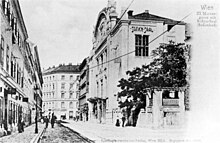17:
33:
145:
surrounding 12,000 square metre area to create the originally planned apartments, a hotel, a catering company, a fitness studio, and various function rooms. It was finally reopened in
December 2013. During the reopening ceremony, the hall was filled with celebrity guests who watched the history of the location as well as a finale through the use of 3D projections from Christie projectors.
25:
140:
In May 2001, the building's owners announced that it would be used as a conference centre. However, it was destroyed by fire on 16 August 2001, due to careless routine maintenance work. The fire burned for more than eight hours and completely destroyed the main ballroom, although the facade and
144:
In
January 2006, it was announced that the Sofiensaal was to be redeveloped and converted into apartments, although the plans changed, building the apartments around the facade. The new owner, ifa AG, painstakingly rebuilt the historic ballroom and listed historical façade. They also used the
100:
adopted the building as its principal
European recording venue for mono recording from 1950 and for stereo recording from 1955 to the mid-1980s. The senior producer of classical recordings for the company for much of this time was
244:
141:
walls of the building survived. Some of the decorative stucco work on the walls survived the fire, as did the adjacent Blauer Salon, a small side venue. There were no reported deaths or injuries.
129:
In the years before the fire, the
Sofiensaal fell into disuse as a recording studio and was used for parties and discos. The last recording made there before the fire, in July 2001, was of
328:
323:
308:
88:
performed there regularly and conducted at the opening ball of the house in 1848. Many of the
Strauss family's waltzes were first performed there.
333:
269:
212:
96:
The building's large, vaulted ceiling, and the pool beneath the floor, gives the hall excellent acoustic properties. For this reason,
227:
76:. It was originally used as a steam bath and known as the Sofienbad. Between 1845 and 1849, it was converted by the architects
165:
313:
318:
182:
109:. Notable recordings made at the Sofiensaal during this period included the first complete studio recording of
77:
60:. The building burned down on 16 August 2001, but it was rebuilt and opened once again in December 2013.
69:
261:
73:
81:
8:
224:
105:, who revolutionised the recording of classical music, particularly opera with the
85:
231:
134:
130:
110:
302:
284:
271:
97:
16:
57:
102:
45:
190:
118:
114:
106:
56:. It is situated on Marxergasse, in the city's third district of
53:
32:
49:
24:
245:"Audio visual solutions that inspire – Christie Digital"
68:
The building was completed in 1826. It was named after
300:
124:
84:into a dance hall and renamed the Sofiensaal.
91:
63:
329:1826 establishments in the Austrian Empire
324:Buildings and structures completed in 1826
160:
158:
20:The Sofiensaal in 2017, after renovations
262:A set of photos of the ruined Sofiensaal
31:
23:
15:
309:Buildings and structures in Landstraße
301:
155:
334:19th-century architecture in Austria
13:
213:Götterdämmerung for the Sofiensaal
14:
345:
255:
48:and recording venue located in
237:
218:
205:
175:
1:
148:
78:August Sicard von Sicardsburg
183:"Decca Tree - WikiRecording"
133:playing solo piano works by
7:
125:Destruction and restoration
28:In 2006, before renovations
10:
350:
70:Princess Sophie of Bavaria
314:Cultural venues in Vienna
319:Concert halls in Austria
215:". gmn.com, August 2001.
92:Use as a recording venue
64:Creation and initial use
234:. Inkpot, December 2004
37:
29:
21:
285:48.20667°N 16.39056°E
187:www.wikirecording.org
74:Emperor Franz Josef I
35:
27:
19:
36:The building in 1900
281: /
166:Death of a princess
82:Eduard van der Nüll
290:48.20667; 16.39056
230:2006-10-16 at the
38:
30:
22:
193:on 1 October 2011
170:Gramophone Online
341:
296:
295:
293:
292:
291:
286:
282:
279:
278:
277:
274:
249:
248:
241:
235:
222:
216:
209:
203:
202:
200:
198:
189:. Archived from
179:
173:
162:
86:Johann Strauss I
72:, the mother of
349:
348:
344:
343:
342:
340:
339:
338:
299:
298:
289:
287:
283:
280:
275:
272:
270:
268:
267:
258:
253:
252:
243:
242:
238:
232:Wayback Machine
223:
219:
210:
206:
196:
194:
181:
180:
176:
163:
156:
151:
127:
117:, conducted by
94:
66:
12:
11:
5:
347:
337:
336:
331:
326:
321:
316:
311:
265:
264:
257:
256:External links
254:
251:
250:
236:
217:
204:
174:
172:. August 2001.
153:
152:
150:
147:
135:Franz Schubert
131:Arcadi Volodos
126:
123:
93:
90:
65:
62:
9:
6:
4:
3:
2:
346:
335:
332:
330:
327:
325:
322:
320:
317:
315:
312:
310:
307:
306:
304:
297:
294:
263:
260:
259:
246:
240:
233:
229:
226:
221:
214:
208:
192:
188:
184:
178:
171:
167:
161:
159:
154:
146:
142:
138:
136:
132:
122:
120:
116:
112:
108:
104:
99:
98:Decca Records
89:
87:
83:
79:
75:
71:
61:
59:
55:
51:
47:
43:
34:
26:
18:
266:
239:
220:
207:
195:. Retrieved
191:the original
186:
177:
169:
143:
139:
128:
103:John Culshaw
95:
67:
46:concert hall
41:
39:
288: /
119:Georg Solti
303:Categories
276:16°23′26″E
273:48°12′24″N
197:12 January
149:References
115:Ring Cycle
107:Decca tree
58:Landstraße
42:Sofiensaal
228:Archived
54:Austria
225:Review
111:Wagner
50:Vienna
44:is a
199:2022
80:and
40:The
168:".
113:'s
305::
185:.
157:^
137:.
121:.
52:,
247:.
211:"
201:.
164:"
Text is available under the Creative Commons Attribution-ShareAlike License. Additional terms may apply.


